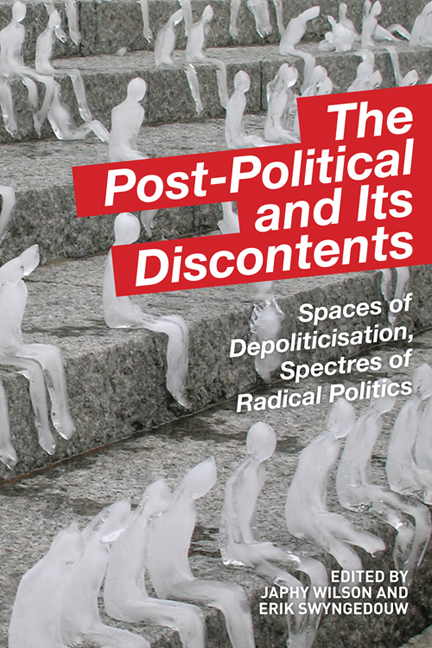Book contents
- Frontmatter
- Contents
- List of Contributors
- Seeds of Dystopia: Post-Politics and the Return of the Political
- Part I Spaces of Depoliticisation
- Part II Spectres of Radical Politics
- 8 Insurgent Architects, Radical Cities and the Promise of the Political
- 9 The Limits of Post-Politics: Rethinking Radical Social Enterprise
- 10 Neither Cosmopolitanism nor Multipolarity: The Political Beyond Global Governmentality
- 11 Against a Speculative Leftism
- 12 Spatialising Politics: Antagonistic Imaginaries of Indignant Squares
- 13 After Post-Politics: Occupation and the Return of Communism
- 14 The Enigma of Revolt: Militant Politics in a ‘Post- Political’ Age
- There Is No Alternative
- Index
12 - Spatialising Politics: Antagonistic Imaginaries of Indignant Squares
from Part II - Spectres of Radical Politics
Published online by Cambridge University Press: 05 August 2016
- Frontmatter
- Contents
- List of Contributors
- Seeds of Dystopia: Post-Politics and the Return of the Political
- Part I Spaces of Depoliticisation
- Part II Spectres of Radical Politics
- 8 Insurgent Architects, Radical Cities and the Promise of the Political
- 9 The Limits of Post-Politics: Rethinking Radical Social Enterprise
- 10 Neither Cosmopolitanism nor Multipolarity: The Political Beyond Global Governmentality
- 11 Against a Speculative Leftism
- 12 Spatialising Politics: Antagonistic Imaginaries of Indignant Squares
- 13 After Post-Politics: Occupation and the Return of Communism
- 14 The Enigma of Revolt: Militant Politics in a ‘Post- Political’ Age
- There Is No Alternative
- Index
Summary
Inspired by the so-called Arab Spring, the Spanish Indignados, Greek Aγανακτισμένοι (Indignants), and London and New York Occupy protests generated a broad range of spatial practices and hegemonic discourses that reasserted the importance of urban public spaces in expressing political dissent (Madden and Vradis 2012; Merrifield 2013; Smith 2013). The protests were met in academic and media analysis with a combination of excitement and cynicism. On the one hand, they kindled hopes for the emergence of a new political imagination and practice, and were therefore hailed as early signs of a nascent global political movement. On the other, they were condemned as a cacophony of disparate voices, with no clear political direction or claims.
This chapter departs from accounts that either deify Indignant Squares as a model for twenty-first-century political praxis (Douzinas 2011, 2013; Rogkas 2011), or demonise them as apolitical/postpolitical crowd gatherings (Pantazopoulos 2011). By performing a closer ethnographic reading of the Indignant protests at Athens’ Syntagma Square, we depict the Indignant Squares as a consensual and profoundly spatialised staging of dissent (Dikec 2005; Swyngedouw 2011), which nevertheless harbours in its underbelly internally conflicting and often radically opposing political imaginaries (Castoriadis 1987; Kaika 2010, 2011). Grounding its analysis on the Greek Aγανακτισμένοι at Syntagma Square, the chapter charts the multiplicity of organisational practices, discourses and spatial configurations at the square, in order to depict the events that took place there neither as a cacophony of apolitical voices, nor as the beginnings of a coherent political movement. A closer look at the organisation, practice and discourses at Syntagma Square unearths the existence of not one, but two distinct Indignant Squares, both at Syntagma, each with its own topography (upper and lower square) and its own discursive and material practice. Although both squares staged dissent, they nevertheless generated different (even opposing) political imaginaries. The upper square began as a gathering of people united by the desire to protest against corruption and political and economic instability, but concluded in xenophobic and racist discourses. The lower square equally began as a gathering of people united by the desire to protest, and evolved into more organised efforts to stage an open democratic politics of solidarity.
The chapter suggests that, rather than focusing on the homogenising term ‘Indignants’ movement’ or ‘Indignant Square’, we should instead be trying to unpack the plurality of politics and internal contradictions within these events.
- Type
- Chapter
- Information
- The Post-Political and Its DiscontentsSpaces of Depoliticisation, Spectres of Radical Politics, pp. 244 - 260Publisher: Edinburgh University PressPrint publication year: 2014



